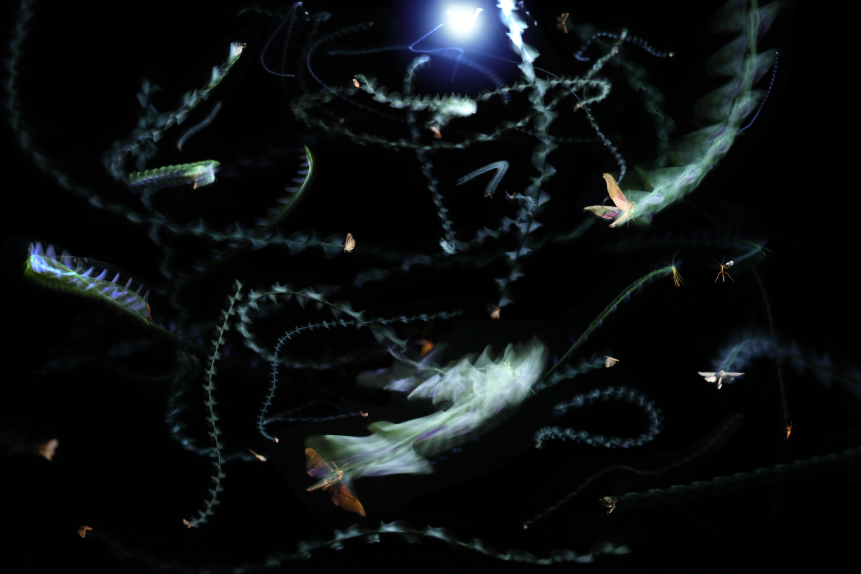The Unexpected Explanation for Insects' Nocturnal Light Circling: Their Disorientation from the Sky

3rd February, 2024
Reviewed according to Science X's editorial guidelines and protocols, this particular article encapsulates key features to bolster its credibility. They include:
- Fact-checking
- Presentation in peer-reviewed publications
- Reliability of source
- Written by scientific researchers
- Proofreading
Article contributors include Samuel Fabian, Jamie Theobald, and Yash Sondhi from The Conversation.
The age-old phenomenon of insects attracted to light, emulated through art, music, and literature, prompts intriguing study. Observations suggest that these nightly gatherings around illumination sources may trap insects, diverting them from nourishment and survival.
Despite many observations, concrete understanding of why this event occurs is still elusive. As researchers studying flight, vision, and evolution, we explored this mystery through high-speed tracking technology, sharing our findings in a Nature Communications publication.
Past hypotheses have witnessed limited validation. An early speculation suggested that insects might be drawn to the warmth of a fire, given that some insects, known as pyrophilic, are fire-seeking and thrive in post-fire conditions. However, the majority of insects drawn to light do not fall into this category, as cooler lights attract them effectively.
An alternative theory suggested phototaxis, a direct attraction towards light, seen in various insects possibly trying to escape darkness or entrapment. However, this theory fails to explain the notable circling behavior, as direct attraction would likely result in a collision with the light source.
Another proposition was that insects confuse artificial light with the moon, with many insects known to use celestial navigation. However, this model suggests many flights spiraling into a collision, inconsistent with the observed behavior. So, what exactly happens?
In order to answer this, we meticulously captured high-speed videos depicting insect flight paths around various light sources in controlled environments. This was carried out both at the Imperial College London and at two field sites in Costa Rica. The results did not correspond closely to any pre-existing models.
Insects seemed to consistently point their backs towards the light in a behavior called the dorsal light response. In the natural world, this helps insects maintain their flight orientation. However, under artificial light, this changes flight paths, causing insects to circle the light source without frequently colliding with it.
We identified more behaviors. Insects under a light source often curved upwards until they stalled and fell from the sky. Interestingly, insects above a light source would flip, turning their backs towards the light before crashing.
While nocturnal light can negatively impact other animals (i.e., attracting migrating birds into urban areas), larger species do not generally lose their orientation as insects do. With insects being the oldest and the most diverse group of creatures with wings, the question remains why they rely on a response that poses significant vulnerability?
It may have to do with their small size. Larger animals can sense gravity directly with sensory organs pulled by its acceleration, or any acceleration. Humans, for example, use the vestibular system of our inner ear, which regulates our sense of balance and usually gives us a good sense of which way is down.
But insects have only small sensory structures. And especially as they perform rapid flight maneuvers, acceleration offers only a poor indication of which way is down. Instead, they seem to bet on the brightness of the sky.
Before modern lighting, the sky was usually brighter than the ground, day or night, so it provided a fairly reliable cue for a small active flyer hoping to keep a steady orientation. The artificial lights that sabotage this ability, by cueing insects to fly in circles, are relatively recent.
As new technology spreads, lights that pervade the night are proliferating faster then ever. With the introduction of cheap, bright, broad-spectrum LEDs, many areas, such as large cities, never see a dark night.
Insects aren't the only creatures affected. Light pollution disrupts circadian rhythms and physiological processes in other animals, plants and humans, often with serious health consequences
But insects trapped around a light seem to get the worst of it. Unable to secure food, easily spotted by predators and prone to exhaustion, many die before the morning comes.
In principle, light pollution is one of the easiest things to fix, often by just flipping a switch. Restricting outdoor lighting to useful, targeted warm light, no brighter than necessary, and for no longer than necessary, can greatly improve the health of nocturnal ecosystems. And the same practices that are good for insects help restore views of the night sky: Over one-third of the world population lives in areas where the Milky Way is never visible.
Although insects circling around a light are a fascinating spectacle, it is certainly better for the insects and the benefits they provide to humans when we leave the night unlit and let them go about the activities they so masterfully perform under the night sky.
Journal information: Nature Communications
Provided by The Conversation
This article is republished from The Conversation under a Creative Commons license. Read the original article.




